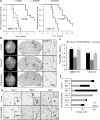Targeting Brain-Adaptive Cancer Stem Cells Prohibits Brain Metastatic Colonization of Triple-Negative Breast Cancer
- PMID: 29567857
- PMCID: PMC5899649
- DOI: 10.1158/0008-5472.CAN-17-2994
Targeting Brain-Adaptive Cancer Stem Cells Prohibits Brain Metastatic Colonization of Triple-Negative Breast Cancer
Abstract
Triple-negative breast cancer (TNBC) exhibits more traits possessed by cancer stem cells (CSC) than other breast cancer subtypes and is more likely to develop brain metastases. TNBC patients usually have shorter survival time after diagnosis of brain metastasis, suggesting an innate ability of TNBC tumor cells in adapting to the brain. In this study, we establish novel animal models to investigate early tumor adaptation in brain metastases by introducing both patient-derived and cell line-derived CSC-enriched brain metastasis tumorsphere cells into mice. We discovered astrocyte-involved tumor activation of protocadherin 7 (PCDH7)-PLCβ-Ca2+-CaMKII/S100A4 signaling as a mediator of brain metastatic tumor outgrowth. We further identified and evaluated the efficacy of a known drug, the selective PLC inhibitor edelfosine, in suppressing the PCDH7 signaling pathway to prohibit brain metastases in the animal models. The results of this study reveal a novel signaling pathway for brain metastases in TNBC and indicate a promising strategy of metastatic breast cancer prevention and treatment by targeting organ-adaptive cancer stem cells.Significance: These findings identify a compound to block adaptive signaling between cancer stem cells and brain astrocytes. Cancer Res; 78(8); 2052-64. ©2018 AACR.
©2018 American Association for Cancer Research.
Conflict of interest statement
Figures





Similar articles
-
EP300 knockdown reduces cancer stem cell phenotype, tumor growth and metastasis in triple negative breast cancer.BMC Cancer. 2020 Nov 10;20(1):1076. doi: 10.1186/s12885-020-07573-y. BMC Cancer. 2020. PMID: 33167919 Free PMC article.
-
Up-modulation of PLC-β2 reduces the number and malignancy of triple-negative breast tumor cells with a CD133+/EpCAM+ phenotype: a promising target for preventing progression of TNBC.BMC Cancer. 2017 Sep 4;17(1):617. doi: 10.1186/s12885-017-3592-y. BMC Cancer. 2017. PMID: 28870198 Free PMC article.
-
Signaling pathway inhibitors target breast cancer stem cells in triple-negative breast cancer.Oncol Rep. 2019 Jan;41(1):437-446. doi: 10.3892/or.2018.6805. Epub 2018 Oct 18. Oncol Rep. 2019. PMID: 30365081
-
"Triple-Negative Breast Cancer Central Nervous System Metastases From the Laboratory to the Clinic".Cancer J. 2021 Jan-Feb 01;27(1):76-82. doi: 10.1097/PPO.0000000000000503. Cancer J. 2021. PMID: 33475296 Free PMC article. Review.
-
Effects of Cancer Stem Cells in Triple-Negative Breast Cancer and Brain Metastasis: Challenges and Solutions.Cancers (Basel). 2020 Jul 31;12(8):2122. doi: 10.3390/cancers12082122. Cancers (Basel). 2020. PMID: 32751846 Free PMC article. Review.
Cited by
-
Analysis of neuroglia and immune cells in the tumor microenvironment of breast cancer brain metastasis.Cancer Biol Ther. 2024 Dec 31;25(1):2398285. doi: 10.1080/15384047.2024.2398285. Epub 2024 Sep 5. Cancer Biol Ther. 2024. PMID: 39238191 Free PMC article. Review.
-
Radiotherapeutic Strategies to Overcome Resistance of Breast Cancer Brain Metastases by Considering Immunogenic Aspects of Cancer Stem Cells.Cancers (Basel). 2022 Dec 29;15(1):211. doi: 10.3390/cancers15010211. Cancers (Basel). 2022. PMID: 36612206 Free PMC article. Review.
-
Imatinib revives the therapeutic potential of metformin on ewing sarcoma by attenuating tumor hypoxic response and inhibiting convergent signaling pathways.Cancer Lett. 2020 Jan 28;469:195-206. doi: 10.1016/j.canlet.2019.10.034. Epub 2019 Oct 28. Cancer Lett. 2020. PMID: 31672491 Free PMC article.
-
HIF-2α regulates CD44 to promote cancer stem cell activation in triple-negative breast cancer via PI3K/AKT/mTOR signaling.World J Stem Cells. 2020 Jan 26;12(1):87-99. doi: 10.4252/wjsc.v12.i1.87. World J Stem Cells. 2020. PMID: 32110277 Free PMC article.
-
Mdig promotes oncogenic gene expression through antagonizing repressive histone methylation markers.Theranostics. 2020 Jan 1;10(2):602-614. doi: 10.7150/thno.36220. eCollection 2020. Theranostics. 2020. PMID: 31903140 Free PMC article.
References
-
- Niikura N, Hayashi N, Masuda N, Takashima S, Nakamura R, Watanabe K, et al. Treatment outcomes and prognostic factors for patients with brain metastases from breast cancer of each subtype: a multicenter retrospective analysis. Breast Cancer Res Treat. 2014;147(1):103–12. - PubMed
Publication types
MeSH terms
Substances
Grants and funding
LinkOut - more resources
Full Text Sources
Other Literature Sources
Medical
Research Materials
Miscellaneous

